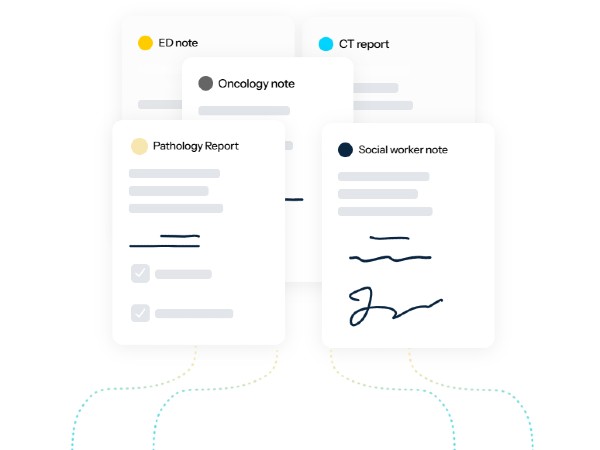

Chart review has mostly been a manual process, has been prone to error, and is an area where extracting actionable insights from medical records has been difficult due to fragmentation. To solve this, Layer Health is using AI. leveraging advanced large language models (LLMs), trained on patient data, so that health systems can automatically review and interpret both structured and unstructured clinical data.
The company’s solution includes automating the extraction of data for clinical registries and quality measurement programs; accelerating patient cohort identification for research studies; enhancing clinical documentation integrity (CDI) and coding processes; and providing physicians and care teams with real-time insight.
Last week, Layer Health announced $21 million in a Series A round led by Define Ventures with participation from Flare Capital Partners, GV and MultiCare Capital Partners. The funding, which brings its total amount raised to $25 million, will be used to expand the company’s offerings, advance its AI models, and deepen partnerships with health systems and other ecosystem partners across the U.S. and beyond.
David Sontag, Ph.D., CEO and Co-Founder of Layer Health spoke to VatorNews about the inefficiences of chart review, how AI can help, and what’s next for the company.
VatorNews: What is the current process when it comes to chart review? What are some of the inefficiencies and problems that come with that?
David Sontag: Today, chart review is a highly manual and time-consuming process. Clinical and administrative teams are tasked with reviewing fragmented patient records—spanning clinical notes, lab results, imaging, and structured EHR data—to answer specific questions for use cases like quality reporting, risk adjustment, and clinical decision-making. The process often requires trained professionals to sift through hundreds of pages per patient, which is both costly and prone to inconsistency.
Inefficiencies stem from data fragmentation across EHR systems and third-party records; high labor costs for clinical reviewers; inaccurate human abstraction – due to human error and review of only a subset of the available data; inconsistent documentation that makes interpretation difficult; and delays in data abstraction, which can negatively impact care timelines
VN: How can AI help? What are some of the ways it can cut down on both cost and time?
DS: AI—especially large language models (LLMs)—are uniquely suited to process and interpret the messy, unstructured data found in medical records. Layer Health uses LLMs trained on longitudinal patient data to automate the chart review process with high accuracy and explainability.
Key benefits include reduction in manual review time by over 65%, as seen in real deployments, as well as cutting operational costs by reducing dependency on clinical abstractors, improving consistency and accuracy across reviewers and sites, delivering structured, usable insights from complex clinical documentation, and supporting compliance and audit-readiness by maintaining traceable logic paths
VN: Walk me through some typical use cases and how your customers use Layer Health.
DS: Layer Health’s platform is modular and designed to support multiple clinical and administrative functions. Some current and upcoming use cases include clinical registry reporting, meaning automating abstraction for quality reporting programs, including those required by health systems and specialty societies.
We also improve hospital operations by delivering guidance about appropriate settings of care for patients. For example, eligibility for having a surgery at an ambulatory surgical center. Another use case is risk adjustment and revenue cycle, where we identify undocumented conditions and documentation gaps to support accurate coding and reimbursement.
Finally, for life sciences research, Layer Health extracts clinical data to match patients to trials or analyze treatment patterns in real-world evidence studies.
VN: What kind of ROI have you been able to calculate for your customers? Do you have hard numbers you can share?
DS: Yes. In one deployment with Froedtert & the Medical College of Wisconsin, Layer Health reduced the time required for chart review by more than 65%. That level of efficiency translates directly into labor cost savings, faster turnaround times, and better resource utilization, particularly for large-scale abstraction and reporting projects.
As Layer Health expands into clinical decision support and revenue optimization use cases, it expects ROI to grow across both financial and clinical performance metrics, especially in value-based care environments.
VN: How many customers do you have now? How fast are you growing?
DS: While the company hasn’t disclosed an exact customer count, Layer Health is working with both provider organizations and life sciences companies, including Froedtert Health and the American Cancer Society. The team has seen strong early traction and is actively scaling both product deployment and commercial partnerships following the Series A.
VN: What offerings and features do you plan to launch now that you have this funding?
DS: Layer Health plans to expand its modular AI platform to support additional functions beyond registry reporting. Upcoming modules will include quality reporting, including custom quality metrics for Value Based Contracting Revenue cycle modules focused on CDI and risk adjustment, and real-time patient routing tools to optimize patient flow around the health system care.
Additionally, the team will invest in making the platform more self-service and interoperable with existing hospital IT infrastructure.
VN: What does it mean when you say you want to advance your AI models? What will that look like and how will you do that?
DS: Advancing the AI models means continuing to train and fine-tune LLMs on real-world clinical data to improve their contextual understanding, accuracy, and ability to generate evidence-based recommendations. This includes enhancing model performance on specific clinical specialties, for example e.g. cardiology and oncology; improving explainability and confidence scoring for end-users; expanding support for multi-modal inputs, like structured lab data; and ensuring alignment with clinical workflows and provider feedback.
VN: What is your ultimate goal with Layer Health? What will success look like for you?
DS: The vision for Layer Health is to become the foundational AI layer across healthcare organizations, enabling smarter decision-making at every level—from research and revenue to frontline care. Success means building an AI platform that’s not just scalable and accurate, but also trusted by clinicians, integrated into workflows, and demonstrably improving outcomes and cost-efficiency across healthcare.
VN: Is there anything else I should know about the company or the new funding round?
DS: Layer Health is solving one of healthcare’s most fundamental infrastructure problems: the ability to make sense of clinical data at scale. Its founding team includes leading experts in machine learning, medicine, and healthcare systems, including MIT and Duke faculty and a practicing emergency physician.
With this Series A, we are poised to expand its reach, deepen our capabilities and demonstrate how generalizable, evidence-based AI can support safer, more efficient and more proactive care—without overburdening clinical teams.














